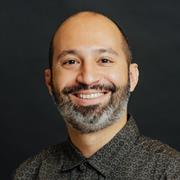Biography
Dr. William Querido is a Research Assistant Professor in Bioengineering at Temple University. His research background is multidisciplinary, including two PhD degrees—in Biomedical Sciences (Biophysics) and Cell Biology, and significant postdoctoral training in fields of biomineralization, skeletal tissue engineering, and biospectroscopy. His research focuses on tissue mineralization in health and disease, with the ultimate goal of translating this knowledge into clinically-relevant outcomes to aid in the diagnosis and treatment of skeletal disorders. He specializes in applications of infrared spectroscopy and imaging modalities to explore the fascinating chemical and molecular mechanisms and complexities of bone development, aging, disease and regeneration. His main ongoing projects aim to reach a deeper understanding on how bone apatite composition and collagen integrity are associated with osteoporosis and bone strength. His research is currently funded by NIH/NIAMS (R21) and PA Department of Health (PA CURE).
Google Scholar: Google Scholar
Labs: Lab website
Research Interests
- Chemistry and biology of mineralized tissues in health and disease
- biomedical applications of infrared spectroscopy and spectral imaging
- skeletal tissue engineering
- cell-matrix-biomaterial interface
Courses Taught
|
Number |
Name |
Level |
|---|---|---|
|
BIOE 0844 |
The Bionic Human |
Undergraduate |
|
BIOE 0944 |
Honors Bionic Human |
Undergraduate |
Selected Publications
Featured
-
Reiner, E., Weston, F., Pleshko, N., & Querido, W. (2023). Application of Optical Photothermal Infrared (O-PTIR) Spectroscopy for Assessment of Bone Composition at the Submicron Scale. Appl Spectrosc, 77(11), pp. 1311-1324. United States. doi: 10.1177/00037028231201427
-
Querido, W., Kandel, S., & Pleshko, N. (2021). Applications of Vibrational Spectroscopy for Analysis of Connective Tissues. Molecules, 26(4). Switzerland. doi: 10.3390/molecules26040922
-
Afara, I.O., Shaikh, R., Nippolainen, E., Querido, W., Torniainen, J., Sarin, J.K., Kandel, S., Pleshko, N., & Töyräs, J. (2021). Characterization of connective tissues using near-infrared spectroscopy and imaging. Nat Protoc, 16(2), pp. 1297-1329. England. doi: 10.1038/s41596-020-00468-z
-
Kandel, S., Querido, W., Falcon, J.M., Reiners, D.J., & Pleshko, N. (2020). Approaches for In Situ Monitoring of Matrix Development in Hydrogel-Based Engineered Cartilage. Tissue Eng Part C Methods, 26(4), pp. 225-238. United States. doi: 10.1089/ten.TEC.2020.0014
-
Querido, W., Shanas, N., Bookbinder, S., Oliveira-Nunes, M.C., Krynska, B., & Pleshko, N. (2020). Fourier transform infrared spectroscopy of developing bone mineral: from amorphous precursor to mature crystal. Analyst, 145(3), pp. 764-776. England. doi: 10.1039/c9an01588d
Recent
-
Ohnishi, T., Tran, V., Sao, K., Ramteke, P., Querido, W., Barve, R.A., Wetering, K.v.d.e., & Risbud, M.V. (2023). Loss of function mutation in Ank causes aberrant mineralization and acquisition of osteoblast-like-phenotype by the cells of the intervertebral disc. Cell Death Dis, 14(7), p. 447. England. doi: 10.1038/s41419-023-05893-y
-
Kim, M., Koyama, E., Saunders, C.M., Querido, W., Pleshko, N., & Pacifici, M. (2022). Synovial joint cavitation initiates with microcavities in interzone and is coupled to skeletal flexion and elongation in developing mouse embryo limbs. Biol Open, 11(6). England. doi: 10.1242/bio.059381
-
Querido, W., Zouaghi, S., Padalkar, M., Morman, J., Falcon, J., Kandel, S., & Pleshko, N. (2022). Nondestructive assessment of tissue engineered cartilage based on biochemical markers in cell culture media: application of attenuated total reflection Fourier transform infrared (ATR-FTIR) spectroscopy. Analyst, 147(8), pp. 1730-1741. England. doi: 10.1039/d1an02351a
-
Shanas, N., Querido, W., Oswald, J., Jepsen, K., Carter, E., Raggio, C., & Pleshko, N. (2022). Infrared Spectroscopy-Determined Bone Compositional Changes Associated with Anti-Resorptive Treatment of the oim/oim Mouse Model of Osteogenesis Imperfecta. Appl Spectrosc, 76(4), pp. 416-427. United States. doi: 10.1177/00037028211055477
-
Kandel, S., Querido, W., Falcon, J.M., Zlotnick, H.M., Locke, R.C., Stoeckl, B., Patel, J.M., Patil, C.A., Mauck, R.L., & Pleshko, N. (2022). In Situ Assessment of Porcine Osteochondral Repair Tissue in the Visible-Near Infrared Spectral Region. Front Bioeng Biotechnol, 10, p. 885369. Switzerland. doi: 10.3389/fbioe.2022.885369
-
Falcon, J.M., Chirman, D., Veneziale, A., Morman, J., Bolten, K., Kandel, S., Querido, W., Freeman, T., & Pleshko, N. (2021). DMOG Negatively Impacts Tissue Engineered Cartilage Development. Cartilage, 13(2_suppl), pp. 722S-733S. United States. doi: 10.1177/1947603520967060
-
Ailavajhala, R., Querido, W., Rajapakse, C.S., & Pleshko, N. (2020). Near infrared spectroscopic assessment of loosely and tightly bound cortical bone water. Analyst, 145(10), pp. 3713-3724. England. doi: 10.1039/c9an02491c
-
Shanas, N., Querido, W., Dumont, A., Yonko, E., Carter, E., Ok, J., Karchner, J.P., Barbe, M.F., Ali, S., Patil, C., Raggio, C., & Pleshko, N. (2020). Clinical application of near infrared fiber optic spectroscopy for noninvasive bone assessment. J Biophotonics, 13(4), p. e201960172. Germany. doi: 10.1002/jbio.201960172
-
Karchner, J.P., Querido, W., Kandel, S., & Pleshko, N. (2019). Spatial correlation of native and engineered cartilage components at micron resolution. Ann N Y Acad Sci, 1442(1), pp. 104-117. United States. doi: 10.1111/nyas.13934


